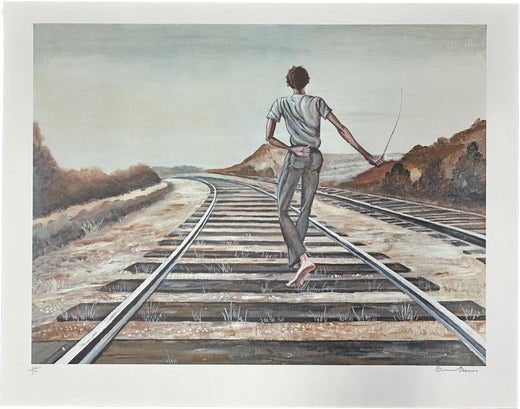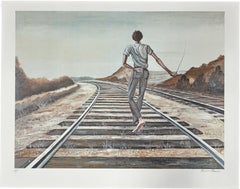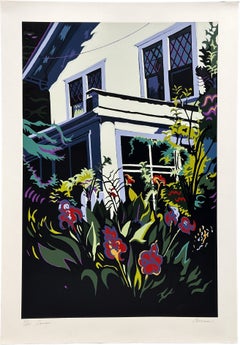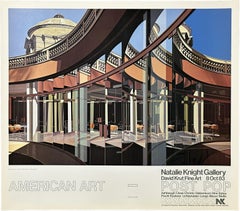Want more images or videos?
Request additional images or videos from the seller
1 of 8
Ernie BarnesDestination Unknown 1979 Signed Limited Edition Lithograph1979
1979
Price:$1,750
About the Item
- Creator:Ernie Barnes (1938 - 2009, American)
- Creation Year:1979
- Dimensions:Height: 25 in (63.5 cm)Width: 19.5 in (49.53 cm)Depth: 1 in (2.54 cm)
- Medium:
- Movement & Style:
- Period:
- Condition:
- Gallery Location:Rochester Hills, MI
- Reference Number:1stDibs: LU2335214529032
Ernie Barnes
Ernie Barnes was an American painter whose artwork reflected African-American lifestyles. As a skilled athlete in numerous sports during his early years of age, Barnes went on to play professional football, and after a five year career, he decided to retire from the sport and paint full-time. It is apparent in his work that he was searching for the perfect medium between racial and ethnic harmony, and many of his paintings reflect it. Barnes continues today to be one of the most widely collected African-American painters of his time.
About the Seller
4.8
Gold Seller
Premium sellers maintaining a 4.3+ rating and 24-hour response times
Established in 2000
1stDibs seller since 2023
89 sales on 1stDibs
Authenticity Guarantee
In the unlikely event there’s an issue with an item’s authenticity, contact us within 1 year for a full refund. DetailsMoney-Back Guarantee
If your item is not as described, is damaged in transit, or does not arrive, contact us within 7 days for a full refund. Details24-Hour Cancellation
You have a 24-hour grace period in which to reconsider your purchase, with no questions asked.Vetted Professional Sellers
Our world-class sellers must adhere to strict standards for service and quality, maintaining the integrity of our listings.Price-Match Guarantee
If you find that a seller listed the same item for a lower price elsewhere, we’ll match it.Trusted Global Delivery
Our best-in-class carrier network provides specialized shipping options worldwide, including custom delivery.You May Also Like
Original "Food Will Win The War" vintage World War 1 poster
By Charles E. Chambers
Located in Spokane, WA
Original World War 1 vintage poster: Food Will Wn the War. Arhival linen backed. PRINTER: Rusling Wood Litho., New York Bright and in good condition. There is some marks down the left side of the poster, possible ink from when the poster was printed.
This poster calls on immigrants to do their part in the war effort. It depicts recent immigrants standing near a sailing ship with the Statue of Liberty and a rainbow stretched across the New York City skyline in the background. The text reads:
You came here seeking Freedom.
You must now help preserve it.
Wheat is needed by the allies.
Waste nothing.
The generosity and compassion of the American people and the great agricultural resources of the North American continent would be called upon... Twenty million Americans signed pledges of membership in the Food Administration...
Category
1910s American Realist Figurative Prints
Materials
Lithograph
$1,100
H 30 in W 20 in D 0.05 in
His Family, American Western Art Lithograph by Duane Bryers
By Duane Bryers
Located in Long Island City, NY
Duane Bryers, American (1911 - 2012) - His Family, Year: 1979, Medium: Lithograph, Signed and Numbered in Pencil, Edition: 300, AP, Image Size: 14.5 x 22.5 in., Size: 21.5 in. ...
Category
1970s American Realist Landscape Prints
Materials
Lithograph
Along the Way, American Western Art Lithograph by Duane Bryers
By Duane Bryers
Located in Long Island City, NY
Duane Bryers, American (1911 - 2012) - Along the Way, Year: 1979, Medium: Lithograph, signed and numbered in pencil, Edition: AP, Image Size: 17 x 22.5 inches, Size: 21.5 in. x ...
Category
1970s American Realist Landscape Prints
Materials
Lithograph
$500
H 21.5 in W 28 in
All The Yesterdays, American Western Art Lithograph by Duane Bryers
By Duane Bryers
Located in Long Island City, NY
Duane Bryers, American (1911 - 2012) - All The Yesterdays, Year: 1979, Medium: Lithograph, signed and numbered in pencil, Edition: 300, AP, Image Size: 16 x 23.5 in., Size: 20.5...
Category
1970s American Realist Landscape Prints
Materials
Lithograph
In Our Birch Grove, American Realist Lithograph by Mel Hunter
By Mel Hunter
Located in Long Island City, NY
Mel Hunter, American (1927 - 2004) - In Our Birch Grove, Year: 1976, Medium: Lithograph, signed and numbered in pencil, Edition: 10, XXV, Size: 22 x 26 in. (55.88 x 66.04 cm)
Category
1970s American Realist Landscape Prints
Materials
Lithograph
Addison County Showplace, American Realist Lithograph by Mel Hunter
By Mel Hunter
Located in Long Island City, NY
Mel Hunter, American (1927 - 2004) - Addison County Showplace, Year: 1976, Medium: Lithograph, signed and numbered in pencil, Edition: M 9/10, Size: 15 x 20 in. (38.1 x 50.8 cm...
Category
1970s American Realist Landscape Prints
Materials
Lithograph
Dodge, American Realist Lithograph by Mel Hunter
By Mel Hunter
Located in Long Island City, NY
Mel Hunter, American (1927 - 2004) - Dodge, Year: 1973, Medium: Lithograph, signed and numbered in pencil, Edition: 110, Size: 22 in. x 29 in. (55.88 cm x 73.66 cm), Description:...
Category
1970s American Realist Landscape Prints
Materials
Lithograph
Le Leze I, American Realist Lithograph by Ivan Theimer
By Ivan Theimer
Located in Long Island City, NY
Ivan Theimer, Czech (1944 - ) - Le Leze I, Year: 1982, Medium: Lithograph, signed and numbered in pencil, Edition: 200, Size: 21 in. x 30 in. (53.34 cm x 76.2 cm)
Category
1980s American Realist Landscape Prints
Materials
Lithograph
Holiday at Sky Farm, American Realist Lithograph by Mel Hunter
By Mel Hunter
Located in Long Island City, NY
Mel Hunter, American (1927 - 2004) - Holiday at Sky Farm, Year: 1994, Medium: Lithograph, signed and numbered in pencil, Edition: 950, Size: 19 in. x 26 in. (48.26 cm x 66.04 cm)
Category
1990s American Realist Landscape Prints
Materials
Lithograph
Big Oak Farm, American Realist Lithograph by Mel Hunter
By Mel Hunter
Located in Long Island City, NY
Mel Hunter, American (1927 - 2004) - Big Oak Farm, Year: 1994, Medium: Lithograph, signed and numbered in pencil, Edition: 950, Size: 19 x 26 in. (48.26 x 66.04 cm), Description:...
Category
1990s American Realist Landscape Prints
Materials
Lithograph
More From This Seller
View AllDestination Unknown 1979 Signed Limited Edition Lithograph
By Ernie Barnes
Located in Rochester Hills, MI
Artist: Ernie Barnes
Title: Destination Unknown
Year: 1979
Print - Lithograph
Size: 25" x 19 ½" inches
Edition: Pencil signed and numbered 24/300
Unframed
‘Destination Unknow...
Category
1970s American Realist Landscape Prints
Materials
Lithograph
Cannas 1978 Signed Limited Edition Screen Print on Arches
By Jon Carsman
Located in Rochester Hills, MI
Jon Carsman
Cannas - 1978
Print - Silkscreen, on Arches archival paper 34½" x 24" in
Edition: Signed in pencil, titled and marked 157/175
"Jon Carsman did for suburban and hometown views what Edward Hopper did for cities, except Carsman exchewed a human presence."
Annette Dixon, curator of the University of Michigan Museum.
Jon Carsman found the source of his inspiration in the play of color and light reflected across the framed houses...
Category
1970s American Realist Landscape Prints
Materials
Screen
$400 Sale Price
20% Off
Jon Carsman Faded Glory 1977 Signed Limited Edition Screen Print
By Jon Carsman
Located in Rochester Hills, MI
Jon Carsman
Faded Glory - 1978
Print - Silkscreen, on Arches archival paper 34¼'' x 24'' inches
Edition: signed in pencil and marked 156/100
image size 20" x 30" inches
“Jon Cars...
Category
1970s American Realist Landscape Prints
Materials
Screen
Urban Landscapes Oct 83 Exhibit
By Richard Estes
Located in Rochester Hills, MI
Artist Name: Richard Estes
Year: 1983
Size-Width Size-Height: 22¾" x 20"
Natalie Knight Gallery
David Krut Fine Art 8 Oct 83
Unframed in Very Good Condition.
Richard Estes is an ...
Category
1980s Abstract Landscape Prints
Materials
Lithograph
1983 Variety Photo Plays Signed Limited Edition Lithograph in colors
By Davis Cone
Located in Rochester Hills, MI
Davis Cone
1983
Variety Photo Plays
Signed in pencil and marked 3/7 PP (Printers Proof)
Lithograph in colors
Paper Size 34½ x 26 inches
Image Size 32½ x 23¼ inches
Eleanor Ettinger G...
Category
1980s Photorealist Landscape Prints
Materials
Lithograph
$680 Sale Price
20% Off
South Of France 1994 Signed Limited Edition Lithograph
By Tony Bennett
Located in Rochester Hills, MI
Tony Bennett
Title: South of France
Lithograph
Signed and Marked ATL 5/5 ( Printers Proof )
Paper Size: 31" x 24" inches
Image Size : 26" x 20" inches
Published By : Atelier E. Ettinger Gallery
Anthony Dominick Benedetto, known professionally as Tony Bennett, is an American singer of traditional pop standards, big band, show tunes, and jazz. He is also a painter, having created works under his birth name that are on permanent public display in several institutions.
Whether he is performing as Tony Bennett or painting as Anthony Benedetto...
Category
1990s American Impressionist Landscape Prints
Materials
Lithograph
$1,760 Sale Price
49% Off




